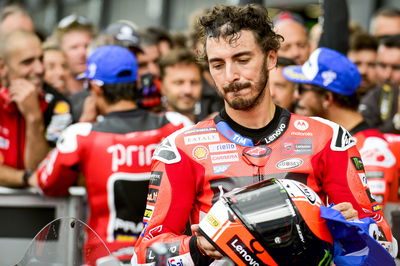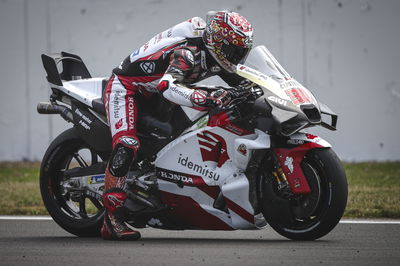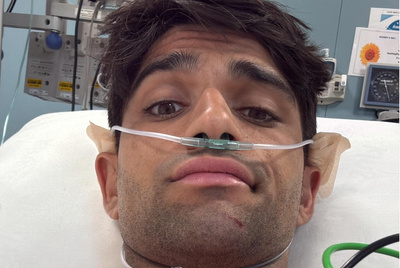How do you solve MotoGP’s “ridiculous” qualifying tow tactics problem?
MotoGP qualifying tactics came under fire at Silverstone, but can anything really be done?

As sure as the sun will rise in the morning, so too will there be a MotoGP rider deliberately cruising around looking for a tow in a qualifying session. That was once again the case at last weekend’s British Grand Prix.
And it led to reigning world champion Francesco Bagnaia putting his foot down. He slammed it as “ridiculous”, while a number of other riders agreed with his assessment. In all honesty, the Silverstone Q2 session wasn’t really the worst display of this kind of behaviour, with the previous rounds in Germany and the Netherlands arguably showing more heinous examples.
The problem in its simplest form is that there is no proper legislation in place to police the matter.
If you are found to have disturbed a rider in any way - deemed irresponsible riding by the FIM rulebook - then you will cop a penalty. That happened to Jorge Martin at Assen when he backed off on the racing line ahead of Raul Fernandez during qualifying. He netted a three-place grid penalty for this transgression, but he only dropped to fifth for the start - and it’s a penalty that only applies for the grand prix.
Fernandez was left in 11th. So he had a lap disturbed but the offender was still ahead of him on the grid. Martin would finish second in the grand prix, Fernandez eighth just under 20 seconds behind him. In the case of Honda wildcard Stefan Bradl in Germany, who backed out of a lap in Q1 at Turn 2, tried to cut to the outside of the track but just got in Marc Marquez’s way, that punishment was even more laughable.
Qualifying second-to-last, the grid penalty left him… last. Meanwhile, Marquez was forced to start 13th. The crime and the punishment are disproportionately balanced. Repeat offenders will start to have long lap penalties handed to them, but even that’s a meek punishment given the seriousness of the problem.
In the case of riders waiting for others to latch onto the back of them, the lack of deterrent means it’s a grey area in the rulebook that will continue to be exploited. And like it or not, you can’t really blame the riders for that.

What are the possible solutions?
The most obvious solution is one already deployed in the Moto2 and Moto3 class. In the latter, slipstreaming is crucial to lap times and in recent years the scenes of groups of riders slowing on racing lines looking for tows became too dangerous.
Minimum sector times were implemented, falling below which would lead to a sliding scale of penalties, with repeat offences netting a competitor harsher sanctions - up to a race ban. However, that hasn’t eradicated the type of behaviour and there are plenty of Moto3 sessions where multiple riders have earned penalties as a result.
But how is that surprising when they see MotoGP riders doing the same thing and getting away with it?
Aprilia’s Aleix Espargaro - who set his Silverstone pole time alone - told the media at the British GP that implementing the Moto2/Moto3 system in MotoGP has been discussed a number of times before in the safety commission. But not everyone agreed with it. And so the circle remains unbroken.
If the Moto2/Moto3 system can’t be agreed on, then perhaps the penalty for irresponsible riding has to be harsher. There wasn’t anything deemed irresponsible during the Silverstone Q2 session, but the scenes of riders riding slowly on the Wellington Straight in the final five minutes would be less likely if the Sword of Damocles hung over everyone’s head in the form of a pitlane start or ride-through penalty if you get in anyone’s way.
Grid penalties, save for being forced to start at the back of the grid, aren’t always a handicap. As Marc Marquez has shown several times this year, you can still get to the podium starting from outside of the top 12. Being forced to start from pitlane is at least a significant disadvantage, while a ride-through for something as dangerous as riding slowly on the racing line is race-ruining enough to teach someone a lesson.
And if the top class is being held accountable, that will filter its way down the ladder, especially to Moto3 where plenty of riders have overcome long lap and grid penalties to get into victory contention.
Altering the qualifying format was suggested in wake of the Silverstone Q2 fallout. Many commentators and fans have called for a Superpole system as the only way of stopping the cruising problem.
It’s something that splits opinion among riders, with Marquez calling it “boring”. The one-by-one system is still used in British Superbikes at some events, and so there is precedent.
MotoGP could also look to reinstate its old qualifying format of a single hour-long session. Increasing the track time gives riders time to fettle with set-ups and reduce the need to look for tows, while the best lap could be set ay any point.
But MotoGP’s switch to the two-group 15-minute shootout format has, for the most part, produced more excitement than either of the aforementioned alternatives.
So, harming the show for the sake of fixing a problem that could be easily managed through harsher sanctions or a change in regulations doesn’t seem sensible.












